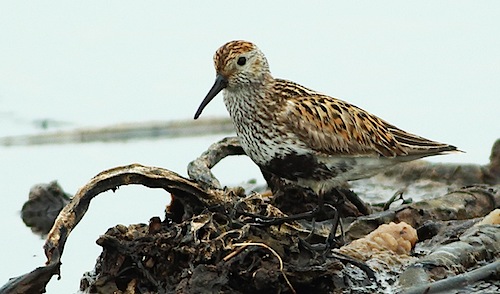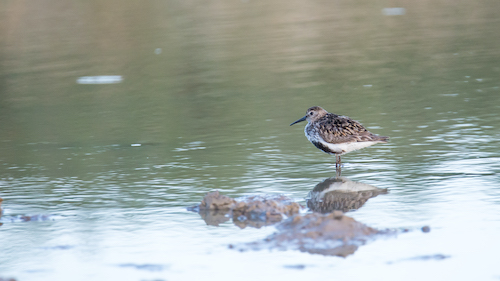 Dunlins can be spotted in estuaries and salt marshes in the autumn and winter.
Dunlins can be spotted in estuaries and salt marshes in the autumn and winter.
Photo: Amanda Scott
Scientific name: Calidris alpina
Other common names: Red-backed Sandpiper, Plover’s Page, Tang Snipe
Conservation status: UK Birds of Conservation Concern, Red; IUCN Red List, Least Concern
What to look for:
- Colouring and appearance: In breeding plumage: reddish cap and back and black belly patch, pale brown head and chest. The non-breeding plumage is browny grey with pale chest and belly and brownish streaking on the upper parts of its breast.
- Size: Length 16 to 20 cm, wingspan 35 to 40 cm.
- Where: Coastline of UK, other than in breeding season when they can be found in upland areas.
- Call: http://www.xeno-canto.org/83894
- Similar species: Knot.
 Dunlins are found round the coastline of the UK in the winter, as they move southwards and downwards from their upland breeding grounds. In its full breeding plumage, the Dunlin is a beauty, complete with rusty-coloured cap and back and the distinctive dark belly patch. It breeds to the north in the Arctic and, in this country, in the Scottish highlands and the uplands of Wales and England (some 9,600 pairs breed in the UK). After bonding, the male of a pair creates some small scrapes lined with vegetation, and the female then selects one and completes the nest building. The clutch size is usually four eggs and, after hatching, both adults tend to the young until they fledge.
Dunlins are found round the coastline of the UK in the winter, as they move southwards and downwards from their upland breeding grounds. In its full breeding plumage, the Dunlin is a beauty, complete with rusty-coloured cap and back and the distinctive dark belly patch. It breeds to the north in the Arctic and, in this country, in the Scottish highlands and the uplands of Wales and England (some 9,600 pairs breed in the UK). After bonding, the male of a pair creates some small scrapes lined with vegetation, and the female then selects one and completes the nest building. The clutch size is usually four eggs and, after hatching, both adults tend to the young until they fledge.
These small waders can more commonly be spotted in winter, even though their plumage is duller in comparison to their summer breeding splendour. Not only can they be seen round the coast in estuaries and salt marshes, but they also often form larger flocks on migration and as they search for food, digging their long, slightly down-turned beak into the sand and mud as they hunt for insects and crustaceans.
Dunlins have a Red status in the UK list of Birds of Conservation Concern. This is because of declining non-breeding populations: the status was raised from Amber in 2007, indicating the continuing concern.
Did you know…?
…Three races of Dunlin (Calidris alpina) are recorded in Britain: C. a. schinzii, which breeds in the British uplands and overwinters in western Africa; C. a. alpina, which breeds in Siberia and overwinters in Britain; and C. a. arctica, which breeds in Greenland and can be spotted on passage in the autumn. So, Dunlins spotted in summer are therefore likely to be of a different race to those spotted in the winter.

More information and references:
Svensson, L., Mullarney, K., Zetterstrom, D.,1986. Collins Bird Guide, second edition (translated by Christie, D., Svensson, L.). HarperCollins, London.
Published: September 2015
Author: Amanda Scott
Photos: Upper, in breeding plumage in Shetland (Amanda Scott); lower, in winter plumage at Windmill Farm (Dougy Wright)
